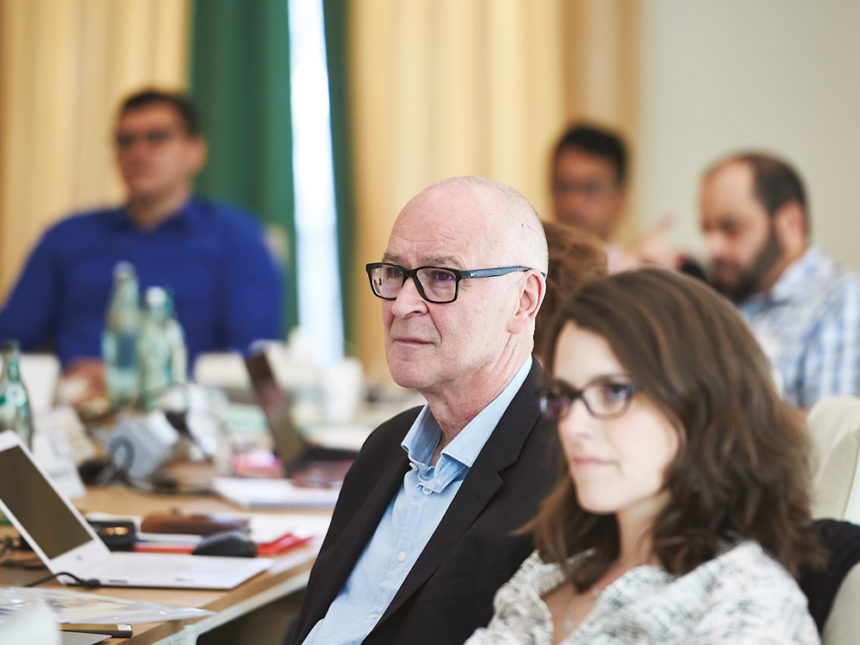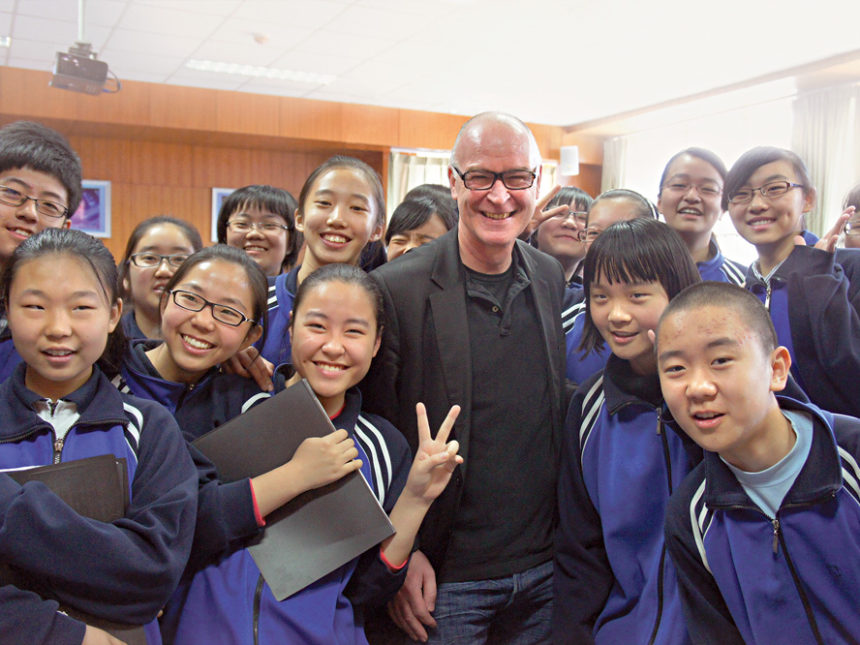


It is sending your message ...

Preparing students for success in their lives is one of the main purposes of learning and teaching. Policy is, at least, one of the influences on education we prepare and provide. I’m not sure that it has ever been true that things changed slowly. Whether true or not, they certainly appear to be changing quickly now, as graphs comparing the adoption of radio, TV, computers, Internet, and mobile phones show. It would be wrong to consider technology as the only change. Fusions across subjects and practice seem to have accelerated change. Ever-changing relationships and new forms of interaction, through social networks and connectedness, have increased acceleration.
Discussions and debates that help us all make sense of this changing world, that encourage collaboration and exchange, and reflections on policy developments across the world, I hope, attract ministers to the Education World Forum. Participation in discussion and debates at the forum, and the actions that have followed, indicate how the subject was received. Continuing and growing discussions of 4th Industrial Revolution issues and their influence on education suggest that interest in this area and the influences it heralds are unlikely to disappear quickly.
I started my career as a civil engineer and recall frequent debate around how to improve the standing of and interest in engineering. More recently, I was delighted to see engaging exhibitions on bridges and tunnels at the Institution of Civil Engineers. Engaging because the exhibitions communicated some of the excitement, and provided building blocks for children to create and construct their own solutions to bridging problems. That activity brought engineering from some disconnected mysterious exercise into something that young people could get close to and explore in their own way.
With science education and performance, I wonder if there’s something to learn from that civil engineering experience. Learning about the implications of science and the benefits that it can bring to your own life might help. Encouraging children to ask their own questions and to test and explore potential solutions might engage their interest more. Learning about scientific method and the importance of practical experimentation, data gathering and analysis of evidence, and learning about science’s interaction with community and society might provide a way to link it better to personal circumstances and lives, and might help engage, delight, and excite interest, participation, and inquiry among our students.
Part of the key to creating a learning society might lie in The Atlas of Economic Complexity by Ricardo Hausmann et al. There the authors argue that “most products used today require more knowledge than can be mastered by any individual”. Think of a car or a plane, and the truth of that statement becomes obvious. As a result, people with different capabilities need to interact with each other, learn from each other and find ways to work together. We have tended to think of learning as an individual pursuit, but Hausmann and Stigliz, among others, take us to a world in which the knowledge capital of nations becomes important. At a slightly smaller scale, some argue that the reason for the success of cities is similar. The great thing about cities is that they may attract people with a similar frame of mind, and the distances between them are small, so that increases the chances of messages and understanding getting through. So just like chips on a circuit board, if the distances between them are small, information can pass more quickly. If you look at innovative companies and start-ups, you’ll find a similar picture.
For an innovation economy, perhaps the first step is getting the components (the people) together and easy to find. The second step is to help communications to happen well, and the third may be to encourage the people involved to learn from each other. That’s where learning literacy comes in. Some argue that learning literacy is more important than established knowledge. Learning literacy allows you to learn on the fly. In my view, it’s not about looking back, or following a list of instructions. It’s more about looking at what’s in front of you and using that as a foundation for new ideas and innovative thinking.

Gavin Dykes, at the IBE consultation meeting on Future Competencies and the Future of Curriculum, Marbach Castle, May 2016.
Collaboration is becoming a greater focus and receiving more attention. That collaboration can be among students, among teachers, or both. Use of technology is helping to drive some of that collaboration, and collaboration is driving some use of technology. Some of that collaboration may be affected by the emergence of this industrial revolution.
Development of competency-based curricula and learning by doing could also be associated with the fourth Industrial Revolution. Andreas Schleicher observes that in the future we will be rewarded not for what we know, but for what we do with what we know. Perhaps with what we learn from what we do. That relates here.
Exploration and discussion of what we can do with technology is having an impact and relates to the 4th Industrial Revolution. I think of the development of 3D printing. 3D printers are additive, making products by building them up in layers. That means we can produce things that were impossible to make before, when industrial processes were invariably about cutting and stamping. In addition, it can now be economic to make single or small numbers of components. This can change formerly accepted industrial practice. Exploring opportunities around these innovations has started in schools and could also be said to be part of the fourth Industrial Revolution. More important than the technology or discussion of it, is the engagement of student minds in what this might mean; it provides opportunities to engage student ideas and innovations.
Increasing consideration of subjects as not being separate and individual, but as linked and collaborative, seems central to the 4th Industrial Revolution’s influence. We also have artificial intelligence, which is increasingly finding its way into education, learning, and our times.
For success now, and most likely in the future, we will have a greater need for people who are creative, who have the ability to think for themselves and the strength to either admit their failure or argue their corner cogently and appropriately. Such people will be better equipped for a world where many repetitive jobs are no longer available. A world where it seems likely that social and commercial enterprises based on new ideas will play a growing role. Encouraging learner voice and building learning around student aspirations seems especially important in this context. I believe student voice can lead to emergent leadership and the ideas and skills of enterprise. Recognizing student aspirations can help students’ sense of purpose, inner motivation, and understanding of what is possible.

Gavin Dykes, learning with music class students and fostering mutual understanding, Beijing.
Mutual understanding and collaboration can help us address the biggest challenges we face, especially when we consider, for example, global challenges reflected in our Sustainable Development Goals.
On the other hand, isolation is damaging, in terms of our own personal welfare. I think that there’s a lot to be said for the positive psychology put forward by Martin Seligman and others, in which doing something good for other people is not just a nice thing to do, but something that contributes to our own well-being.
At another level, economic arguments, as I mentioned earlier, suggest collaboration is required and a driver for innovation and improvement. All in all, fostering collaboration and mutual understanding seem to me powerful and critical foundations on which to keep building.
As we move further into the 21st century and some of the activities of previous times become something for the history books, we need to work at things to take their place. Patterns of community-based activities, ways in which we meet people and gently keep up to date with them, are changing and influenced by the adoption of technologies. We need to take care of people who become excluded by such changes, and we need to ensure there are plenty of alternative ways to socialize, to collaborate, and to build mutual understanding.
I suspect we have a fair way to go before the 4th Industrial Revolution and its ripples recede. However, that’s just dodging your excellent question.
The Empty Brain is, I think, a thought-provoking article by Robert Epstein published on aeon.co. The article discusses the view that your brain does not process information, retrieve knowledge, or store memories. In short: your brain is not a computer. It goes on to explain that over centuries we have used the latest in technology to try to understand how the brain might work. Epstein cites George Zarkadaris’s book In our own Image, which begins with the Greeks who used the ‘humours’ and hydraulic models to explain human intelligence. Then in the 1500s it was springs and gears. In the 1700s electricity and chemistry provided the metaphor. In the 1800s how our brains worked was linked to the telegraph. And then of course came computers. None of these has brought us much closer to understanding how the brain really works.
That journey through the ages reminded me a little of the journey through industrial revolutions. I wonder if understanding of the brain has any chance of leading to the next industrial revolution, the 5th. If we ever understand enough about the human brain, its extraordinary capacity and wonders, then perhaps we could use it to build on the fusion of physical, digital, social and biological worlds that the 4th Industrial Revolution has promised. It might be a big step up from the current technological developments.
If that were the focus of the 5th industrial revolution, what would please me most is people being right at its center, and I’d wish for it to be all people, their welfare, and their success in community.